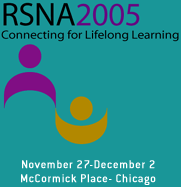
Abstract Archives of the RSNA, 2005
LPD08-02
Diagnostic Value of Multi-Detector Row CT-Angiography (MD-CTA) in the Evaluation of Occlusions and Stenoses of the Basilar Artery and Relevance of the Hyperdense Basilar Artery Sign: Results of a Pilot Study
Scientific Posters
Presented on November 28, 2005
Presented as part of LPD08: Neuroradiology/Head and Neck (Stroke: Diagnosis)
Birgit Betina Ertl-Wagner MD, Presenter: Nothing to Disclose
Jennifer Linn, Abstract Co-Author: Nothing to Disclose
Christoph Richard Becker MD, Abstract Co-Author: Nothing to Disclose
Hartmut Brueckmann, Abstract Co-Author: Nothing to Disclose
Maximilian Ferdinand Reiser MD, Abstract Co-Author: Nothing to Disclose
Roland Ditmar Bruening MD, Abstract Co-Author: Nothing to Disclose
We aimed to assess the diagnostic value of multi-detector row CT-angiography (MD-CTA) in patients with occlusions or stenoses of the basilar artery and to elucidate the relevance of the sign of the hyperdense basilar artery.
30 patients (21m/9f; age 67.4+/-17.5 years, age range 20 to 89 years) presenting with signs and symptoms of hind circulation ischemia were included in this study. MD-CTA was performed on a 16- or on a 64-slice MDCT with a standardized protocol. Evaluation was performed independently by three blinded readers on standardized forms; the reading orders were randomized. In addition, unenhanced CT scans were evaluated qualitatively and quantitatively regarding the hyperdense basilar artery sign. Results were correlated with biplanar selective DSA as the reference standard.
DSA demonstrated 14 thrombotic occlusions and 2 high-grade (>90%) stenoses of the basilar artery. The sensitivity of the CTA was 95.8, the specificity was 97.6. The positive predictive value of CTA was 97.9, the negative predictive value 97.9. In addition, CTA was able to demonstrate 3 extravascular pathologies in the remaining patients. Qualitative assessment of the hyperdense basilar artery sign led to 4 false positive and 10 false negative findings. Quantitative RoI analysis of the basilar artery demonstrated a mean attenuation of 36,0+/-7,6 HU in the patent vessels and of 41.4+/-12.4HU in the thrombotically occluded arteries. Differences between the groups were not significant (p>0.05).
MD-CTA demonstrated excellent sensitivity and specificity parameters in the diagnostic evaluation of diseases of the basilar artery as compared to biplanar DSA. The hyperdense basilar artery sign should not serve as the basis for diagnostic and therapeutic decision making due to its low diagnostic performance, though.
We aimed to assess the diagnostic value of multi-detector row CT-angiography (MD-CTA) in patients with occlusions or stenoses of the basilar artery and to elucidate the relevance of the sign of the hyperdense basilar artery.
30 patients (21m/9f; age 67.4+/-17.5 years, age range 20 to 89 years) presenting with signs and symptoms of hind circulation ischemia were included in this study. MD-CTA was performed on a 16- or on a 64-slice MDCT with a standardized protocol. Evaluation was performed independently by three blinded readers on standardized forms; the reading orders were randomized. In addition, unenhanced CT scans were evaluated qualitatively and quantitatively regarding the hyperdense basilar artery sign. Results were correlated with biplanar selective DSA as the reference standard.
DSA demonstrated 14 thrombotic occlusions and 2 high-grade (>90%) stenoses of the basilar artery. The sensitivity of the CTA was 95.8, the specificity was 97.6. The positive predictive value of CTA was 97.9, the negative predictive value 97.9. In addition, CTA was able to demonstrate 3 extravascular pathologies in the remaining patients. Qualitative assessment of the hyperdense basilar artery sign led to 4 false positive and 10 false negative findings. Quantitative RoI analysis of the basilar artery demonstrated a mean attenuation of 36,0+/-7,6 HU in the patent vessels and of 41.4+/-12.4HU in the thrombotically occluded arteries. Differences between the groups were not significant (p>0.05).
MD-CTA demonstrated excellent sensitivity and specificity parameters in the diagnostic evaluation of diseases of the basilar artery as compared to biplanar DSA. The hyperdense basilar artery sign should not serve as the basis for diagnostic and therapeutic decision making due to its low diagnostic performance, though.
Ertl-Wagner, B,
Linn, J,
Becker, C,
Brueckmann, H,
Reiser, M,
Bruening, R,
Diagnostic Value of Multi-Detector Row CT-Angiography (MD-CTA) in the Evaluation of Occlusions and Stenoses of the Basilar Artery and Relevance of the Hyperdense Basilar Artery Sign: Results of a Pilot Study. Radiological Society of North America 2005 Scientific Assembly and Annual Meeting, November 27 - December 2, 2005 ,Chicago IL.
http://archive.rsna.org/2005/4415088.html

